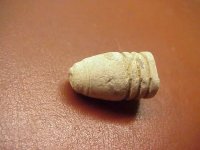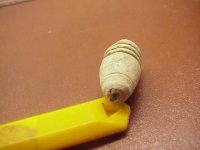High Plains Digger
Established Users
NEW THOUGHTS--SCROLL ON DOWN 4/15/11What's with this bullet? Pulled or poured?
There is some new information about the "ring around the bullet". New to me, anyway, and maybe somewhat of a new reveleation to some of y'all. Scroll on down towards the end for more thought-provoking conversation.---HPD 4/14/11
----------------------------- ------------------------------------ ------------------------------------ ----------------
I am not sure what happened to this bullet. At first, I thought it was a pulled bullet, pulled with a claw/screw combination. Then I did a little reading, and now I suspect it was a nose cast Southern product, due to the mark on the nose, and mis-aligned side seam. I suspect that the "hole" in the nose is actually an imperfection in the sprue (short lead pour?), not a screw hole. Any ideas out there?


There is some new information about the "ring around the bullet". New to me, anyway, and maybe somewhat of a new reveleation to some of y'all. Scroll on down towards the end for more thought-provoking conversation.---HPD 4/14/11
----------------------------- ------------------------------------ ------------------------------------ ----------------
I am not sure what happened to this bullet. At first, I thought it was a pulled bullet, pulled with a claw/screw combination. Then I did a little reading, and now I suspect it was a nose cast Southern product, due to the mark on the nose, and mis-aligned side seam. I suspect that the "hole" in the nose is actually an imperfection in the sprue (short lead pour?), not a screw hole. Any ideas out there?


Last edited:

